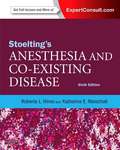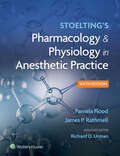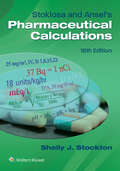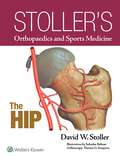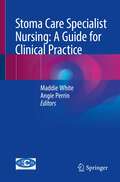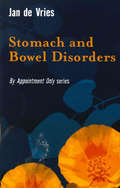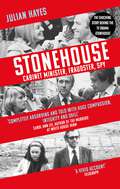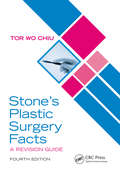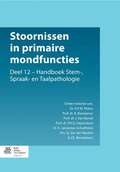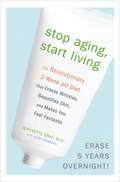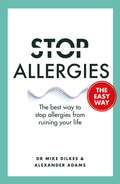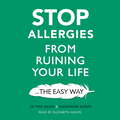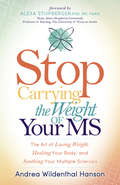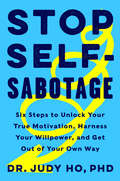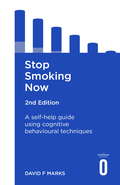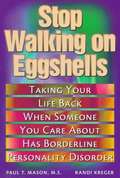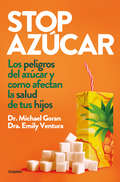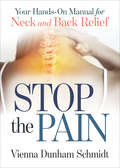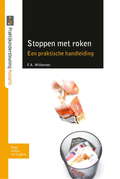- Table View
- List View
Stoelting's Anesthesia And Co-existing Disease
by Roberta L. Hines Katherine MarschallWith Stoelting's Anesthesia and Co-Existing Disease, you'll have the succinct, yet thorough guidance you need to successfully avoid or manage complications stemming from pre-existing medical conditions. Advanced research from experts in the field will help you overcome the toughest challenges in practice, letting you offer your patients the best care, each and every time. Deliver anesthesia as safely as possible with extensive coverage of the pathophysiology of numerous coexisting conditions. Effectively manage special patient populations with a focus on pediatric, geriatric, and adult patients. Master the ins and outs of a wide range of diseases, from common to rare, through detailed discussions of each disease's unique features.
Stoelting's Pharmacology & Physiology in Anesthetic Practice
by Richard D. Urman James P. Rathmell Pamela FloodComprehensive, readable, and clinically oriented, Stoelting’s Pharmacology & Physiology in Anesthetic Practice, Sixth Edition, covers all aspects of pharmacology and physiology that are relevant either directly or indirectly to the anesthetic practice—a challenging topic that is foundational to the practice of anesthesia and essential to master. This systems-based, bestselling text has been thoroughly updated by experts in the field, giving you the detailed information needed to make the most informed clinical decisions about the care of your patients.
Stoklosa and Ansel's Pharmaceutical Calculations
by Shelly J. StocktonThe gold standard on pharmaceutical calculations, this widely acclaimed text covers the full range of calculations pharmacy students must learn for successful pharmacy practice, including dosing, compounding, metric conversions and more. Thoroughly reviewed by practitioners and educators and extensively revised and updated, this 16th edition maintains high standards for both academic and basic practice requirements while offering the most comprehensive and in-depth coverage of pharmacy calculations available. A consistent, step-by-step approach makes it easy to work through the problems and gain a greater understanding of the underlying concepts, and new online access to calculation problems makes this the most engaging edition yet.
Stolen Kiss with the Single Mom (Harlequin Lp Medical Ser.)
by Deanne AndersA stolen moment…A lifetime together?Three years ago, single mom and nurse Lacey lost her husband in the same IED blast that left his best friend, ER doc Scott, with an injured leg and survivor’s guilt. Thrill seeker Scott’s sworn to always be there for cautious Lacey… And on one fraught night shift, this leaves them entwined in an electrifying kiss—an impulsive encounter that has him longing to keep her in his protective embrace always…“This story captivated me. I enjoyed every moment it. This is a great example of a medical romance. Deanne Anders is an amazing writer!”—Goodreads on The Surgeon’s Baby Bombshell“What an utterly captivating, fast-paced, memorable read Ms. Anders has delivered in this book where the chemistry between this couple is off-the-charts…the dialogue was entertaining and had me hooked from the very beginning and even more so once the hero and heroine come face-to-face….”—Harlequin Junkie on From Midwife to Mommy
Stolen Nights with the Single Dad
by Alison RobertsFollowing your heart…is worth the risk!When GP Andrew Mitchell signed up for an emergency responders training course, he never expected to leave with a certificate and a night of memories with instructor Jenna Armstrong! Returning to reality, Andrew juggles work with being a single dad, but staying focused is impossible with Jenna invading his thoughts. Their worlds are poles apart, and on paper they should never work, but Andrew isn&’t ready to let Jenna go… &“I was attracted by the blurb description of this book. I loved the characters though and the overall arc of the story. It&’s a well-written book. I&’m sure fans of Harlequin Medical Romance will enjoy this book.&”-Harlequin Junkie on A Pup to Rescue Their Hearts&“I loved everything about Falling for the Secret Prince. Alison has written great characters and managed to put in fun moments that leave you laughing. She&’s managed to pull at my heartstrings and make me sigh. I&’m definitely looking forward to reading more books from her.&”-Goodreads
Stoller's Orthopaedics and Sports Medicine: The Hip
by David W. StollerDiagnose hip imaging like never before with this outstanding multimedia reference from a world-renowned expert in orthopaedic radiology! Stoller's Orthopaedics and Sports Medicine: The Hip combines more than 25 years of trailblazing research and clinical experience into one comprehensive, must-have resource. Concise, bulleted text, accompanied by hundreds of clear line drawings, full-color illustrations, and high-resolution 3T images, allows for rapid understanding and easy access to unprecedented insights supporting the effective diagnosis of a full range of hip disorders.
Stoma Care Specialist Nursing: A Guide for Clinical Practice
by Maddie White Angie PerrinThis book provides specialist and general nurses with a comprehensive guide to the art and science of stoma care nursing, from the Association of Stoma Care Nurses UK, the only association for SCNs in UK.The chapters follow a schematic outline of knowledge required for nurses caring for patients who are undergoing stoma surgery; from the essence of nursing to the management of patients living with a long term condition. It also presents and discusses the issues surrounding the clinical picture such as prescription and community issues as well as sources of support available for patients. This text serves as an excellent resource for all disciplines of health care staff caring for individuals living with a stoma.
Stomach and Bowel Disorders
by Jan de VriesThe stress and anxieties of modern life can take their toll on the digestive system. If not treated in their early stages, simple digestive and absorption disorders can develop into serious conditions such as ulcers, colitis or irritable bowel syndrome. Jan de Vries shares the results of 30 years' successful treatment of stomach and bowel problems, showing the reader how to interpret the body's warning signals and setting out simple and effective remedies, diets and exercises.
Stoned
by David CasarettA doctor discovers the surprising truth about marijuanaNo substance on earth is as hotly debated as marijuana. Opponents claim it's dangerous, addictive, carcinogenic, and a gateway to serious drug abuse. Fans claim it as a wonder drug, treating cancer, anorexia, AIDS, chronic pain, glaucoma, arthritis, migraines, PTSD, and insomnia. Patients suffering from these conditions need--and deserve--hard facts based on medical evidence, not hysteria and superstition.In Stoned, palliative care physician Dr. David Casarett sets out to do anything--including experimenting on himself--to find evidence of marijuana's medical potential. He smears mysterious marijuana paste on his legs and samples pot wine. He poses as a patient at a seedy California clinic and takes lessons from an artisanal hash maker. In conversations with researchers, doctors, and patients around the world he learns how marijuana works--and doesn't--in the real world.Dr. Casarett unearths tales of near-miraculous success, such as a child with chronic seizures who finally found relief in cannabidiol oil. In Tel Aviv, he learns of a nursing home that's found success giving marijuana to dementia patients. On the other hand, one patient who believed marijuana cured her lung cancer has clearly been misled. As Casarett sifts the myth and misinformation from the scientific evidence, he explains, among other things:* Why marijuana might be the best treatment option for some types of pain* Why there's no significant risk of lung damage from smoking pot* Why most marijuana-infused beer or wine won't get you highOften humorous, occasionally heartbreaking, and full of counterintuitive conclusions, Stoned offers a compassionate and much-needed medical practitioner's perspective on the potential of this misunderstood plant.From the Hardcover edition.
Stonehouse: Cabinet Minister, Fraudster, Spy
by Julian Hayes'The minister's nephew recounts an extraordinary life . . . a vivid account'HENRY DE QUETTEVILLE, Telegraph'Completely absorbing and told with huge compassion, integrity and skill'CAROL ANN LEE, author of The Murders at White House Farm and A Passion For Poison'What a book. I didn't have to turn the pages. They turned themselves I literally consumed the book in just a few hungry sittings . . . Julian Hayes is perfectly placed to tell this story, particularly it's captivating human side . . . most definitely a must read'DR SALEYHA AHSAN, filmmaker and journalist, CambridgeIn November 1974, British MP and former cabinet minister John Stonehouse walked into the sea off a beach in Miami and disappeared, seemingly drowned. Then he was found - on the other side of the world, in Australia - and his extraordinary story began to come to light: a Labour cabinet minister and a devoted family man; also in a long-term affair with his secretary, and a spy for the Czech State Security agency, who had committed fraud and attempted to fake his own death to escape catastrophic business failures. Was it a mental breakdown as he later claimed? Or were there more sinister reasons for his dramatic disappearance? This is the definitive biography of Stonehouse, written by Julian Hayes, who, as the son of Stonehouse's nephew and lawyer, Michael Hayes, is uniquely placed to tell the story of this charismatic but deeply flawed politician. As a criminal lawyer in London, Hayes has used his in-depth knowledge and experience of the criminal courts, not least the Old Bailey, where the Stonehouse trial took place, to forensically examine Stonehouse's story, including Czech defector Josef Frolík's claim that he was a spy. Hayes has unearthed secret reports in the archives in Prague written by Stonehouse's former spymasters. He has also gleaned much from family members and lawyers involved in the trial and from the trial documents and other government papers held in archives in the UK and Australia.
Stonehouse: Cabinet Minister, Fraudster, Spy
by Julian Hayes'Completely absorbing and told with huge compassion, integrity and skill'CAROL ANN LEE, author of The Murders at White House Farm and A Passion For Poison'What a book. I didn't have to turn the pages. They turned themselves I literally consumed the book in just a few hungry sittings . . . Julian Hayes is perfectly placed to tell this story, particularly it's captivating human side . . . most definitely a must read'DR SALEYHA AHSAN, filmmaker and journalist, CambridgeIn November 1974, British MP and former cabinet minister John Stonehouse walked into the sea off a beach in Miami and disappeared, seemingly drowned. Then he was found - on the other side of the world, in Australia - and his extraordinary story began to come to light: a Labour cabinet minister and a devoted family man; also in a long-term affair with his secretary, and a spy for the Czech State Security agency, who had committed fraud and attempted to fake his own death to escape catastrophic business failures. Was it a mental breakdown as he later claimed? Or were there more sinister reasons for his dramatic disappearance? This is the definitive biography of Stonehouse, written by Julian Hayes, who, as the son of Stonehouse's nephew and lawyer, Michael Hayes, is uniquely placed to tell the story of this charismatic but deeply flawed politician. As a criminal lawyer in London, Hayes has used his in-depth knowledge and experience of the criminal courts, not least the Old Bailey, where the Stonehouse trial took place, to forensically examine Stonehouse's story, including Czech defector Josef Frolík's claim that he was a spy. Hayes has unearthed secret reports in the archives in Prague written by Stonehouse's former spymasters. He has also gleaned much from family members and lawyers involved in the trial and from the trial documents and other government papers held in archives in the UK and Australia.
Stonehouse: Cabinet Minister, Fraudster, Spy
by Julian HayesThe true story behind the 2023 ITV series, STONEHOUSE, starring Matthew Macfayden and Keeley Hawes. 'An extraordinary life . . . a vivid account' Telegraph 'Completely absorbing' CAROL ANN LEE, author of The Murders at White House Farm and A Passion For Poison 'I literally consumed the book in just a few hungry sittings . . . most definitely a must read' DR SALEYHA AHSAN, filmmaker and journalist, Cambridge In November 1974, British MP and former cabinet minister John Stonehouse walked into the sea off a beach in Miami and disappeared, seemingly drowned. Then he was found - on the other side of the world, in Australia - and his extraordinary story began to come to light: a Labour cabinet minister and a devoted family man; also in a long-term affair with his secretary, and a spy for the Czech State Security agency, who had committed fraud and attempted to fake his own death to escape catastrophic business failures. Was it a mental breakdown as he later claimed? Or were there more sinister reasons for his dramatic disappearance? This is the definitive biography of Stonehouse, written by Julian Hayes, who, as the son of Stonehouse's nephew and lawyer, Michael Hayes, is uniquely placed to tell the story of this charismatic but deeply flawed politician.
Stone’s Plastic Surgery Facts: A Revision Guide
by Tor ChiuStone's Plastic Surgery Facts 4e provides a complete revision tool for the FRCS exit examination in plastic surgery. Written in the form of notes and lists, the full range of plastic surgery topics is covered as follows, wound care, burns, head & neck, cleft lip and palate and craniofacial anomalies, breast, hand and upper limb, lower limb, skin and soft tissue tumours, genitourinary and trunk, aesthetic and general plastic surgery. Updated article summaries and a review section in each chapter highlight important points and explain common misconceptions. A vital resource for the surgical trainee.
Stoornissen in pimaire mondfuncties: Deel 12 - Handboek Stem-, Spraak- en Taalpathologie
by R. Bastiaanse J. Borsel K. Jansonius-Schultheiss Sj. Meulen B.J.E. Mondelaers H.F.M. PetersHet Handboek Stem-Spraak-Taalpathologie verscheen tussen 1997 en 2007 gefaseerd in losse afleveringen. Daarin werd alle kennis op het gebied van de stem-, spraak- en taalpathologie vanuit verschillende disciplines samengebracht. Het Handboek is bestemd voor iedereen die klinisch-praktisch of meer theoretisch is geïnteresseerd, of vanuit een ander vakgebied hiermee in aanraking komt. Voor logopedisten, artsen, linguïsten, spraak- en taalpathologen, audiologen, pedagogen en psychologen in Nederland en België is het Handboek een onmisbare vraagbaak.Deel 12 behandelt stoornissen in primaire mondfuncties.
Stop Aging, Start Living
by Alisa Bowman Jeannette GrafThough other skin-care experts have identified free radicals and cellular inflammation as key triggers to the breakdown of healthy skin, renowned dermatologist and former National Institutes of Health fellow Jeannette Graf, M. D. , has discovered a way to prevent these saboteurs from developing in the first place—rather than just treating the symptoms they’ve caused. Based on the scientifically groundbreaking premise that our cells—and consequently our skin—can only function best when the pH balance of our body is at its proper level, Dr. Graf’s four-part plan focuses on changing your body’s ratio of acids to alkalines. Most of us tend to eat three acidic-building foods (like sugar, refined carbs, meat, and dairy) for every one alkalinizing food (dark green leafy vegetables, garlic, onions, olive oil, lemon, fruit, nuts and seeds, and whole grains)—the reverse of the ideal ratio. And while changing your diet is important, food is not the only way to shift this ratio or reverse the cell aging that’s affecting your skin. The plan also includes detailed information on: • daily alkalinizing “cocktails” • quality calcium-mineral supplements • probiotic supplements (good bacteria in a bottle) • how to assess your skin and care for it accordingly—choosing the right cleansers, moisturizers, and treatments that will give you the most noticeable results (hint: many of these products line the shelves of your local drugstore) • the joy prescription: activities that can add exhilaration and laughter to your life and increase the neuropeptides in the brain that actually rejuvenate skin cells • nutrients in foods that enhance cell energy production and cell signaling But don’t just take her word for it:Stop Aging, Start Livingis filled with testimonials from her patients. Whether you want to see results fast (with her twenty-four-hour kickstart plan), ease into it (with the two-week prescription), or just incorporate a fewStop Aging, Start Livingstrategies into your life as they suit you, you’ll come away looking and feeling incredibly younger. From the Hardcover edition.
Stop Allergies The Easy Way: The best way to stop allergies from ruining your life
by Alexander Adams Dr Mike DilkesMany of us are affected by allergies, from the dreaded hayfever - the scourge of the summer - to much talked-about food allergies such as lactose and gluten. Dr Mike Dilkes, one of Harley Street's top Consultant ENT Surgeons, reveals his top tips for living with and treating an allergy.- Find out the difference between a sensitivity, an intolerance and an allergy- Discover how allergies affect your body and why- Learn how to see through the hype and take control of your own symptoms- Prevent attacks and treat outbreaksWith a no-nonsense approach to this controversial topic, Stop Allergies from Ruining Your LIfe... The Easy Way provides a straightforward analysis ofthe latest scientific research, allowing you to live the life you want, whatever the season.
Stop Allergies The Easy Way: The best way to stop allergies from ruining your life
by Alexander Adams Dr Mike DilkesMany of us are affected by allergies, from the dreaded hayfever - the scourge of the summer - to much talked-about food allergies such as lactose and gluten. Dr Mike Dilkes, one of Harley Street's top Consultant ENT Surgeons, reveals his top tips for living with and treating an allergy. - Find out the difference between a sensitivity, an intolerance and an allergy- Discover how allergies affect your body and why- Learn how to see through the hype and take control of your own symptoms- Prevent attacks and treat outbreaksWith a no-nonsense approach to this controversial topic, Stop Allergies the Easy Way provides a straightforward analysis ofthe latest scientific research, allowing you to live the life you want, whatever the season.Read by Dr Mike Dilkes(p) 2018 Orion Publishing Group
Stop Arguing with Your Kids
by Michael NicholsFor parents fed up with constant challenges to their authority-but who dread becoming tyrants in their own homes-this book provides a powerful new alternative to "because I said so." Trusted family therapist and author Michael P. Nichols takes on the number-one problem of parents today with the insight and humor that has made his earlier The Lost Art of Listening an enduring bestseller. Presented is a simple, easy-to-follow, yet remarkably effective way to put an end to arguments by refusing to argue back. Instead, the techniques of responsive listening help parents open up better communication in the family; create an atmosphere of respect and cooperation; and take children's feelings into account-without giving in to their demands. Loads of realistic examples help parents defuse whining and defiance and manage common conflicts with preschoolers to teens.
Stop Carrying the Weight of Your MS: The Art of Losing Weight, Healing Your Body, and Soothing Your Multiple Sclerosis
by Andrea Wildenthal HansonMake your own rules for weight loss instead of breaking someone else&’s! Losing weight doesn&’t have to mean sacrificing happiness–especially when you want to do what&’s best for your body and your MS. If you&’re ready to make your health a top priority and find your individual answer to healing your body then Stop Carrying the Weight of Your MS is an essential piece of the puzzle. Losing weight is a known solution to slowing multiple sclerosis progression and making symptoms more manageable. But diets can be very complex and restrictive, leaving people to feel lacking and like they&’re failing at staying healthy. The good news is losing weight doesn&’t have to be like that. Diagnosed with multiple sclerosis in 2000, Hanson found the key to lasting lifestyle change is making personally meaningful decisions. Building on books like Terry Wahls&’ The Wahls Protocol, and other MS diet books, Hanson moves beyond intense diets and regimens to help her readers create a new way of eating that is sustainable and customizable.
Stop Self-Sabotage: Six Steps to Unlock Your True Motivation, Harness Your Willpower, and Get Out of Your Own Way
by Judy Ho, PhD PhDAward-winning clinical psychologist and TV personality Dr. Judy Ho helps you stop the cycle of self-sabotage, clear a path to lasting happiness, and start living your best life in this a must-have guide perfect for fans of You Are a Badass, Unf*ck Yourself, and How to Stop Feeling Like Sh*t. Have you ever had a deadline for a big work project, only to find yourself down to the wire because you spent too much time on social media? Or gotten excited about meeting someone new, only to convince yourself he isn’t really interested? How many Januarys have you resolved that this is the year you’re finally going to lose the weight, only to abandon your diet in just a few weeks? If these scenarios sound familiar, you are stuck in a cycle of self-sabotage.At one point or another, we’ve all done something that undermines our best interests and intentions. Even the most successful people get in their own way—often without realizing it. In Stop Self-Sabotage, licensed clinical psychologist, tenured professor, and television personality Dr. Judy Ho takes a fresh look at self-sabotage to help us answer two vital questions: Why do we do it? How do we stop? Combining therapeutically proven strategies with practical tools and self-assessments, Dr. Judy teaches you how to identify your triggers, modify your thoughts and behaviors, find your true motivation, and unlock your willpower to stop this vicious cycle in its tracks. Practical and transformative, Stop Self-Sabotage is your ultimate guide to jumpstart lasting, positive change and start living the life you want.
Stop Smoking Now 2nd Edition: A self-help guide using cognitive behavioural techniques
by David F. MarksHave you ever tried to give up smoking?Most smokers have. It is even more difficult to avoid relapse - after days, weeks or even years - and the long-term results of many stop smoking programmes are disappointing. But this week-long programme can help you stop smoking for good.Professor David F Marks uses techniques from cognitive behavioural therapy (CBT), which has been proven to be effective by teaching you how to 're-program' your mind to not want to smoke. You will no longer have to rely on willpower alone to give up smoking. By becoming aware of your smoking triggers and dealing with the thoughts and behaviours that lead you to smoke automatically, over the course of a week you will gradually find your cravings disappear altogether.You will learn:· Exercises and strategies to help you regain control from your smoking automatic pilot· Advice on relaxation and stress reduction· How to avoid future relapses· Why alternative approaches such nicotine replacement therapy or e-cigarettes are less effective· Tips on healthy eating and exercise to manage weightStop Smoking Now will help you not only give up your habit, but help you to remain a non-smoker for life.Overcoming self-help guides use clinically proven techniques to treat long-standing and disabling conditions, both psychological and physical. Many guides in the Overcoming series are recommended under the Reading Well Books on Prescription scheme. Series Editor: Professor Peter Cooper
Stop Walking on Eggshells: Taking Your Life Back When Someone You Care about Has Borderline Personality Disorder
by Paul T. Mason Randi KregerPeople with Borderline Personality Disorder (BPD) challenge those close to them with their often bewildering mood shifts and unpredictable behavior. For those people who have relationships with persons with BPD, whether they be relatives, friends, spouses, parents, or children, this book should prove a godsend. It delineates the ways in which borderline individuals' (BPs) behavior and communications frustrate and perplex those around them but goes further in articulating specific strategies that those close to the person with Borderline Personality Disorder (non-BPs, as they are termed in this book) can effectively cope with these kinds of behaviors.
Stop azúcar: Los peligros del azúcar y cómo afectan a la salud de tus hijos
by Michael I. Goran Emily VenturaUn destacado investigador en nutrición infantil y una experimentada educadora en salud pública explican el peligro oculto que representa el azúcar para el desarrollo y la salud de los niños y ofrecen a los padres un programa esencial «a prueba de azúcar» de 7 y 28 días. La mayoría no sabemos lo dañino que es el azúcar para el hígado, el corazón y el cerebro en crecimiento de los niños. En su investigación, el doctor Michael Goran descubrió que su exceso no solo causa obesidad infantil, sino que provoca problemas de salud en los niños sin sobrepeso, y es probable que sea uno de los culpables de gran parte de los problemas de comportamiento, emocionales y de aprendizaje. En esta guía eliminan los mitos sobre los diversos tipos de azúcares y edulcorantes, ayudan a las familias a identificar fuentes engañosas de azúcar en sus dietas y sugieren soluciones realistas. Con un desafío de 7 y 28 días para ayudar a las familias a elegir la cantidad adecuada de azúcar en sus dietas, junto con más de 35 recetas, todas sin azúcares añadidos, cualquiera puede darles a sus hijos un nuevo comienzo de vida saludable. La crítica ha dicho:«Este libro me dejó alucinado y subraya la importancia de que todos reduzcamos la ingesta de azúcar y almidón para protegernos no solo a nosotros mismos, sino también a nuestras generaciones futuras.»Mark Hyma, doctor y escritor. «Cómo y con qué alimentamos a nuestros niños es de suma importancia. En este libro, Emily y Michael iluminan hábilmente la naturaleza del azúcar en nuestro mundo actual, y qué papel debe desempeñar en la dieta de un niño. Es una lectura esencial para padres, educadores y comensales.»Alice Waters, chef, autora y fundadora de Edible Schoolyard
Stop the Pain: Your Hands-On Manual for Neck and Back Relief
by Vienna Dunham SchmidtStop the Pain presents tried-and-true pain-relieving techniques in an easy-to-follow guide. Veteran massage therapist, Vienna Schmidt has worked with hundreds of people with chronic pain, empowering her clients to take their healing into their own hands. In Stop the Pain, Vienna shares her tried-and-true pain-relieving techniques in an easy-to-follow guide where those suffering can discover:What causes tension, stabbing or burning pain, and knots in their neck and backStrategies that work to relieve pain (and save the money they’ve been spending on therapies that didn’t work or didn’t last) A way to get back to feeling great and sleeping without pain How their brain comes back when the constant pain messages stop How great it is to have the power to get themselves out of pain
Stoppen met roken, een praktische handleiding
by F. WillemsenStoppen met roken, een praktische handleiding
